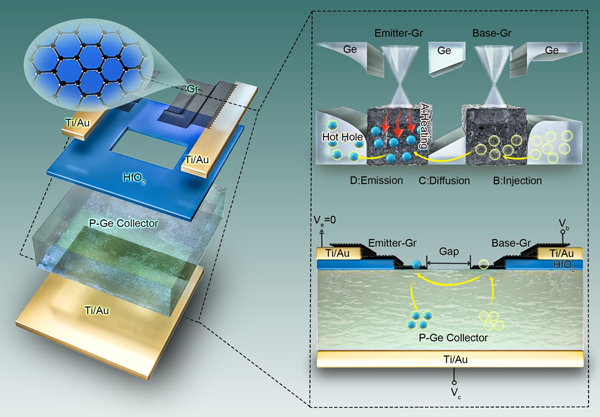Transistors, the building blocks of integrated circuits, face growing challenges as their size decreases. Exploring transistors with novel operating principles has become crucial to enhance circuit performance. Hot carrier transistors, which utilize the excess kinetic energy of carriers, have the potential to improve the speed and functionality of transistors. However, their performance has been limited by traditional mechanism of hot carrier generation.
A team of researchers led by Prof. LIU Chi, Prof. SUN Dongming and Prof. CHENG Huiming from the Institute of Metal Research (IMR) Chinese Academy of Sciences has proposed a novel hot-carrier generation mechanism named as the “stimulated emission of heated carriers (SEHC)” and developed an innovative hot-emitter transistor (HOET), achieving an ultralow sub-threshold swing less than 1 mV/dec and a peak-to-valley current ratio exceeding 100, provide a prototype of low power and multifunctional device for the post-Moore era .
This groundbreaking work was published in Nature.
Low-dimensional materials like graphene, due to their atomic thickness, excellent electrical and optical properties, and perfect surface without defects, can easily form hetero-structures with other materials. This creates a variety of energy band combinations, offering new possibilities for developing novel hot carrier transistors. Researchers at IMR develop a hot-emitter transistor using a combination of graphene and germanium, leading to an innovative mechanism for hot-carrier generation.
This new transistor is composed of two coupled graphene/germanium Schottky junctions. During the operation, germanium injects high-energy carriers into the graphene base, which then diffuse to the emitter, triggering a substantial current increase with the preheated carriers there. This design achieves a sub-threshold swing of less than 1 mV/dec, surpassing the conventional "Boltzmann limit" of 60 mV/dec. Additionally, the transistor exhibits a peak-to-valley current ratio exceeding 100 at room temperature, and demonstrate the potential in multi-valued logic computing.
"This work opens a new realm in transistor research, adding a valuable member to the family of hot carrier transistors and showing broad prospects for their application in future high-performance, low-power, multifunctional devices." said LIU.
The study was conducted in collaboration with REN Wencai's team from IMR and ZHANG Lining's team from Peking University.

A hot-emitter transistor based on stimulated emission of heated carriers (Image by IMR)

Carrier Stimulated Emission in Hot-Emitter Transistor (Image by IMR)